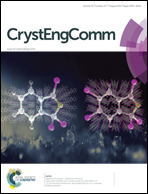A hydrothermally stable transition alumina by condensation-enhanced self-assembly and pyrolysis crystallization: application in the steam reforming of methane†
Abstract
The preparation of a steam-based hydrothermally stable transition alumina is reported. The gel was derived from a synthetic sol–gel route where Al-tri-sec-butoxide is hydrolysed in the presence of a non-ionic surfactant (EO20PO70EO20), HCl as the catalyst and water (H2O/Al = 6); the condensation was enhanced by treating the hydrolysed gel with tetrabutylammonium hydroxide (TBAOH), after which it was dried at 60 °C by solvent evaporation. The so-obtained mesophase was crystallized under argon at 1200 °C (1 h) producing a transition alumina containing δ/α, and possibly θ, alumina phases. Due to its surface acidity, the pyrolysis conditions transform the block copolymer into a cross-linked char structure that embeds the alumina crystallites. Calcination at 650 °C generates a fully porous material by burning the char; a residual carbon of 0.2 wt.% was found, attributed to the formation of surface (oxy)carbides. As a result, this route produces a transition alumina formed by nanoparticles of about 30 nm in size on average, having surface areas in the range of 59–76 m2 g−1 with well-defined mesopores centered at 14 nm. The material withstands steam at 900 °C with a relative surface area rate loss lower than those reported for δ-aluminas, the state-of-the-art MSU-X γ-alumina and other pure γ-aluminas. The hydrothermal stability was confirmed under relevant CH4 steam reforming conditions after adding Ni; a much lower surface area decay and higher CH4 conversion compared to a state-of-the-art MSU-X based Ni catalyst were observed. Two effects are important in explaining the properties of such an alumina: the char protects the particles against sintering, however, the dominant effect is provided by the TBAOH treatment that makes the mesophase more resistant to coarsening and sintering.


 Please wait while we load your content...
Please wait while we load your content...